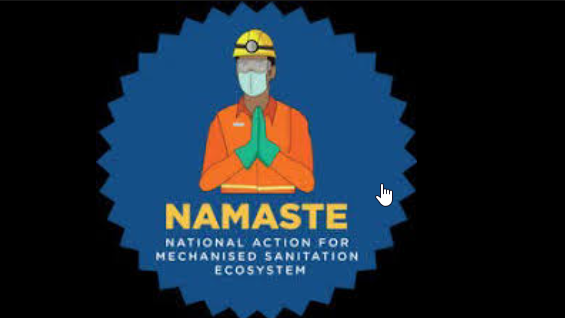NAMASTE Scheme
The National Action for Mechanized Sanitation Ecosystem (NAMASTE) Scheme, a joint initiative by the Ministry of Social Justice and Empowerment and the Ministry of Housing and Urban Affairs, aims to eliminate the hazardous practice of manual sewer and septic tank cleaning.
The scheme, implemented by the National Safai Karamcharis Finance and Development Corporation (NSKFDC) from FY 2023-24 to FY 2025-26, has a budget allocation of 349.73 crores and focuses on providing a range of entitlements to Sewer and Septic Tank Workers (SSWs).
Key Components of the NAMASTE Scheme
The NAMASTE Scheme comprises several components designed to support and empower SSWs:
- Profiling of SSWs in Urban Local Bodies (ULBs) through digital tools, with the goal of identifying approximately 1 lakh SSWs.
- Providing health insurance to SSWs under the Pradhan Mantri Jan Arogya Yojana (PM-JAY).
- Offering occupational safety training to SSWs and establishing Sanitation Response Units for NAMASTE.
- Providing capital subsidy up to Rs. 5.00 lakh for the procurement of sanitation-related vehicles and equipment.
- Distributing Personal Protective Equipment (PPE) to SSWs.
- Distributing safety devices to Emergency Response Sanitation Units (ERSUs).
- Conducting Information, Education, and Communication (IEC) campaigns to raise awareness about SSW safety and dignity.
- Profiling Process and NAMASTE Mobile Application Training
The first component of the NAMASTE Scheme focuses on creating a national database of SSWs by profiling them and assigning a unique NAMASTE ID. To initiate the profiling process, online training sessions on the profiling process and the NAMASTE Mobile Application were conducted for 30 States/UTs across all five zones.
A total of 2,367 ULBs attended the training, which was given to participants including Executive Officers, Executive Engineers, Senior Public Health Inspectors, and Chief Officers nominated by the State government as ULB Nodal Officers for NAMASTE, as well as surveyors such as Sanitary Inspectors, Assistant Engineers, and Computer Operators.
State-level NAMASTE Profiling Training
Ten states/UTs conducted state-level NAMASTE Profiling training to resolve technical queries, which was attended by 805 urban local bodies. Following the online training, a sanitation profile of each city is being collected from the ULBs through an online form, which includes data on SSWs, functional and existing machines, and the estimated number of camps a ULB will conduct. A Camp Preparatory VC is then conducted with the states to address any discrepancies in the data and assist the states with the preparedness of conducting profiling camps.
Training of Trainers on NAMASTE Mobile App Usage
Training of Trainers programs were conducted in four states, including Uttar Pradesh (physical training), Karnataka, Andhra Pradesh, and Telangana (online training), to ensure that officers have a clear understanding of the app and scheme in their regional language. Uttar Pradesh and Delhi (Delhi Jal Board) have also conducted physical training sessions.
Profiling Camps for SSWs and IEC Campaign
After the successful completion of training on profiling and the usage of the NAMASTE App/portal, profiling has started in 28 states, along with a proper Information Education Communication (IEC) campaign conducted by states through print, electronic, and mass media. As of 6th March, 2024, a total of 28,732 SSWs have been surveyed, and 21,760 have been validated.
Month: Current Affairs - March, 2024
Category: Government Schemes Current Affairs


